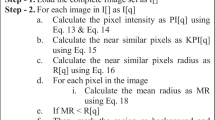Abstract
In this paper, we propose a method of elaborating and detecting brain tumor from MRI suitable for information sharing via the internet for a healthcare provider. This method allows for reducing image sizes without reducing the information content of the images in terms of detecting tumors. The proposed method involves first clarifying the brain tumor area using a modified K-means clustering method and initial segmentation using mean shift segmentation. Then a threshold setting is used to convert the gray scale image and remove noise by applying an erode operation. Finally, the brain tumors in the images are detected using a watershed algorithm. The proposed method was compared with two well-known methods namely the conventional K-mean clustering and Fuzzy C Means (FCM) clustering. We verified the precision and the objectivity of our proposed method. The average precision and recall for our proposed method were excellent with values of 0.914052 and 0.995641, respectively. Our method detected more brain tumors than the conventional K-means clustering and FCM clustering methods and was able to provide for an efficient image data processing with reduced file sizes.










Similar content being viewed by others
References
Li, M., Jing, Y., & Li, C. (2013). A robust and efficient cross-layer optimal design in wireless sensor networks. Wireless Personal Communication, 72(4), 1889–1892.
Kim, K., Lee, J., & Lee, J. (2014). Energy efficient and reliable ARQ scheme (E2 R-ACK) for mission critical M2M/IoT service. Wireless Personal Communication, 78(4), 1917–1933.
Lee, D. W., & Kim, J. H. (2010). High reliable in-network data verification in wireless sensor networks. Wireless Personal Communication, 54(3), 501–519.
Durmus, Y., & Onur, E. (2015). Service knowledge discovery in smart machine networks. Wireless Personal Communication, 81(4), 1455–1480.
Han, H. H., Lee, G. S., Lee, J. Y., & Lee, S. H. (2012). Region segmentation technique based on active contour for object segmentation. Society of Digital Policy and Management, 12(1), 167–172.
Lee, S. K., Park, Y. S., Lee, G. S., & Lee, S. H. (2013). An automatic object extraction method using color features of object and background in image. Society of Digital Policy and Management, 11(12), 459–465.
Wang, P., & Wang, H. L. (2008). A modified FCM algorithm for MRI brain image segmentation. In International seminar on Proceedings of future biomedical information engineering, 2008. FBIE’08 (pp. 26–29).
Malyszko, D., & Wirezchon, S. T. (2007) Standard and Genetic k-means Clustering Techniques in Image Segmentation. In 6th international conference on proceedings of computer information system and industrial management application (CISIM’07) (pp. 299–304).
Kim, G. O., Lee, G. S., & Lee, S. H. (2014). An edge extraction method using K-means clustering in image. Society of Digital Policy and Management, 12(11), 281–288.
Bezdek, J. C., Ehrlich, R., & Full, W. (1984). FCM: The fuzzy C-means clustering algorithm. Computers and Geosciences, 10(2–3), 191–203.
Kim, T. H., Park, D. C., Jeong, T. K., Lee, Y. S., & Min, S. Y. (2011). MRI data segmentation using fuzzy C-mean algorithm with intuition. Institute of Korean Electrical and Electronics Engineers (IKEEE), 15(3), 191–197.
Wang, S., Geng, Z., Zhang, J., Chen, Y., & Wang, J. (2014). A fuzzy C-means model based on the spatial structural information for brain MRI segmentation. International of Journal of Signal Processing, Image Processing and Pattern Recognition, 7(1), 313–322.
Zhou, H., Schaefer, G., Sadka, A. H., & Celebi, M. E. (2009). Anisotropic mean shift based fuzzy C-means segmentation of dermoscopy images. Selected Topics in Signal Processing, IEEE, 3(1), 26–34.
Hwang, Y. C., Yoon, H. J., & Cha, E. Y. (2010). Modified mean shift for color image segmentation and vehicle color recognition. Institute of Electronics and Information Engineers (IEEK), 6, 2126–2129.
Beucher S., & Lantuejoul, C. (1979) Use of watershed in contour detection. In Proceedings of international workshop on image processing. CCETT/IRISA, Rennes, France.
Shin, D. K., & Moon, Y. S. (2014). Automatic detection of objects-of-interest using visual attention and image segmentation. Institute of Electronics and Information Engineers (IEEK), 51(5), 137–151.
Villmann, T., Kaden, M., Lange, M., & Hermann, W. (2014) Precision-recall-optimization in learning vector quantization classifiers for improved medical classification system. In 2014 IEEE symposium on proceedings of computational intelligence and data mining (CIDM) (pp. 71–77).
Acknowledgments
This study is sponsored by the 2016 research fund of Kwangwoon University.
Author information
Authors and Affiliations
Corresponding author
Rights and permissions
About this article
Cite this article
Kim, J., Lee, S., Lee, G. et al. Using a Method Based on a Modified K-Means Clustering and Mean Shift Segmentation to Reduce File Sizes and Detect Brain Tumors from Magnetic Resonance (MRI) Images. Wireless Pers Commun 89, 993–1008 (2016). https://doi.org/10.1007/s11277-016-3420-8
Published:
Issue Date:
DOI: https://doi.org/10.1007/s11277-016-3420-8




